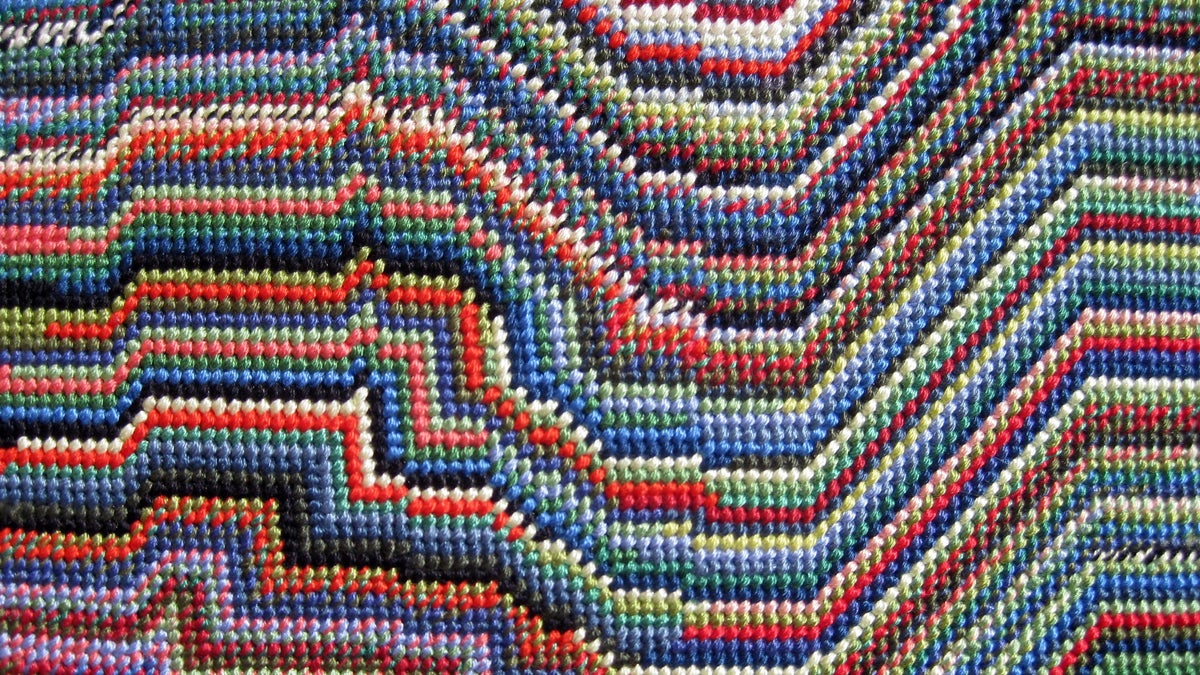When art has no story to tell, it doesn’t need to make sense
Listen
This image shows a detail from a needlepoint work by Mary Smull on display at the Rebekah Templeton gallery in Philadelphia. (Image courtesy of Mary Smull)
Some art does not have a story that wants to be told. Art can be less about lives, things and history, and more about color, line and shape. An audio tour for an exhibition from artist collective Grizzly Grizzly does not describe or explain or tell the story of the artist. Rather, it is a sonic extension of the artist collective’s process.
As an arts and culture reporter for WHYY/NewsWorks, my job is to tell stories about art.
Some art does not have a story that wants to be told.
Art can be less about lives, things and history, and more about color, line and shape. To impose a story onto a brilliant red, or a coy arc, can do a disservice to the work.
“A lot of heritage museums, in particular, are very interested in telling a story in order to give those objects and those things life so that people find them interesting,” said Jacque Liu, whose day job as program associate with the Pew Center for Arts and Heritage takes him through many museums.
But Liu is also an artist, making sculptural and conceptual installation work. Sometimes his day job bleeds into his art practice. “I’ve been trying to figure out what is the kind of story I can tell with my work.”
The thing is, he really doesn’t want to tell a story with his work.
Don’t speak
“I’ve been interested in not being able to talk about it,” said Liu. “In school, from undergrad to graduate school, there’s always this ‘Must articulate; must talk about it.’ When I left, I started doing other stuff — artist collective and things like that — where I’ve had to articulate those kinds of things. But it became more fun to not be able to talk about stuff.”
I share Liu’s desire to react to art without explaining it. I created a series of audio pieces to accompany the installation of work by the artist collective Grizzly Grizzly (of which Liu is a member) now on view at the Rebekah Templeton gallery in Northern Liberties.
Museum audio tours are often flawed things, bearing illuminating facts, useful background, and curatorial insight, while at the same time offering museumgoers a crutch with which to navigate the art. How many times have you walked into a blockbuster art exhibition to find a room crowded with people, all wearing cheap headphones, or pressing an audio wand to their ears?
Who here has ever clicked “play” before opening your eyes to the art in question?
Who here has wanted to turn off the machine and stand, unaided, in front of a sculpture or a painting or a photograph, to see what happens?
Stop making sense
The audio pieces I created for Grizzly Grizzly play with — and hopefully expand — the tropes of a museum audio tour. The pieces start with the voice (I interviewed all six members of Grizzly Grizzly on tape) but are not necessarily linear. Each of the three stops pairs two members of the collective talking about their work.
I started with the material of my own art: sound. Based on what they said on the recordings, I searched for connections. Then, as though it were paint on a canvas, I pushed the sound around until it felt right.
I discovered that all of the members of Grizzly Grizzly struggle with narrative. They all harbor a compulsion to tell stories, and they fight to free their work from the constraints of storytelling. A work that “makes sense” usually makes a single kind of sense, keeping it from working on you, abstractly.
Likewise, the Grizzly Grizzly tour does not attempt to describe the art, explain what it means, or tell the story of the artist. Rather, the audio tour is a sonic extension of the artist collective’s process.
“I don’t think about plot. I think about character,” said Mary Smull, another member of Grizzly Grizzly who makes abstract needlepoint. “What makes a great character so engaging? That tension between the part of the character you can understand and the part you can’t understand, reconciling that into one being. The best images do that, too. There’s enough complication in the image that it takes a while for the mind to reconcile the parts. There’s more than one answer to the question. That’s a good sign.”
WHYY is your source for fact-based, in-depth journalism and information. As a nonprofit organization, we rely on financial support from readers like you. Please give today.


